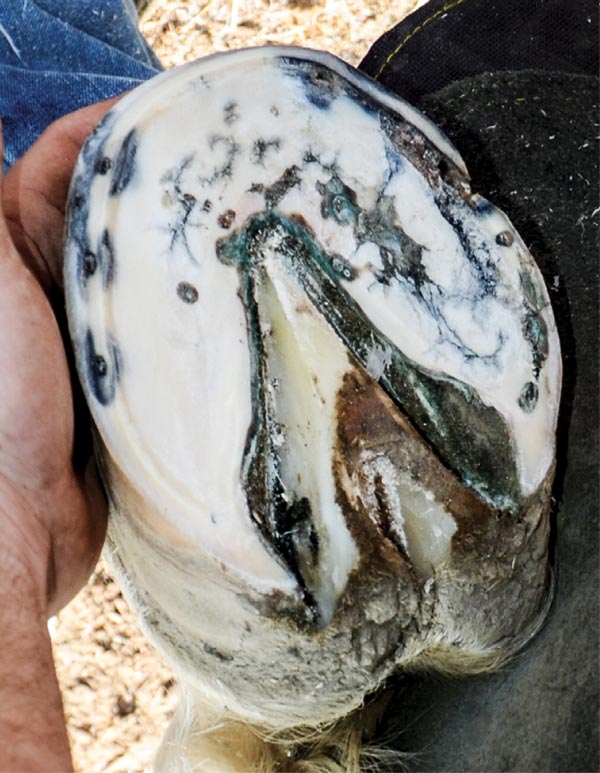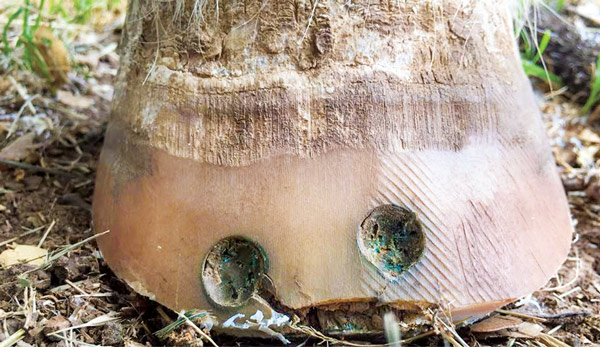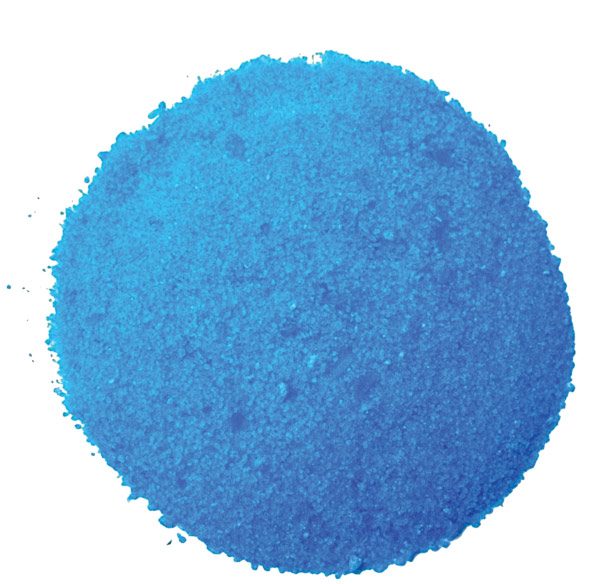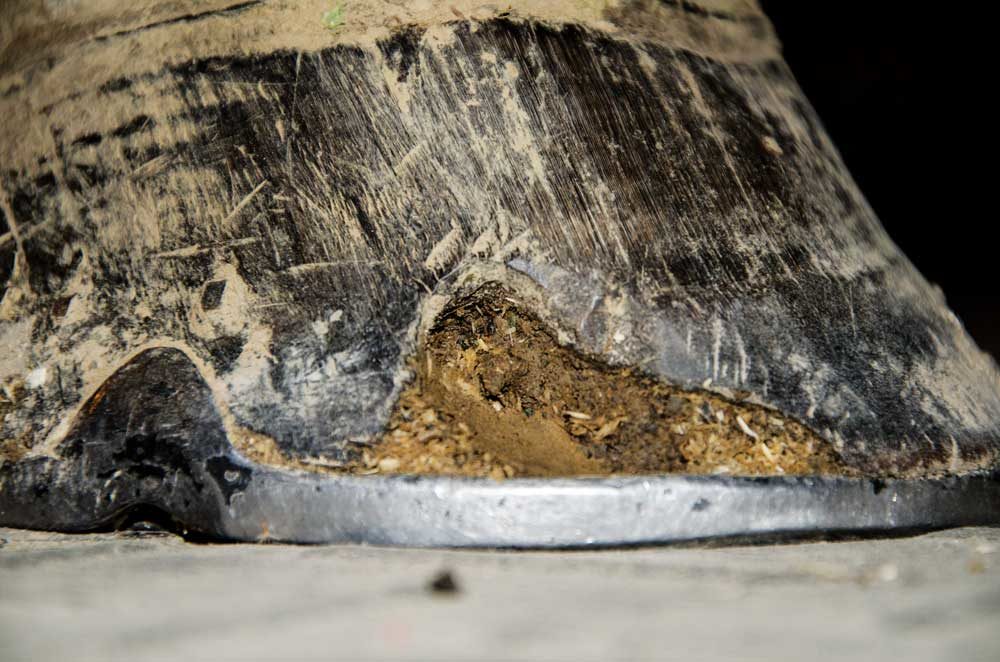Theoretically, treatment for white line disease should be simple — kill infection-causing bacteria and fungi. In reality, treating white line disease can be far more complicated.
Bacteria and fungi naturally exist inside the hoof wall in a mutually beneficial relationship. In “Taking the Mystery Out of White Line Disease,” SBS Equine researchers Dr. M. John Partens and Dr. Richard Shakalis explained that each organism breaks down in the hoof in a different manner.
In a healthy hoof, these organisms keep each other in a regulated balance. In an unhealthy foot, they take advantage of access to a rich blood supply and create an infection, most often in the stratum medium. Because these organisms counteract each other and prevent one another from over-generating, one can’t be corrected without correcting the other.
Farrier Takeaways
- Regularly scheduled hoof-care visits provide an opportunity to
head off white line disease. - Effective treatment of white line disease includes eradicating the
defect and addressing underlying foot pathologies. - Less is more. Avoid removing too much hoof tissue and use
antiseptics judiciously.
Although bacteria and fungi cause white line disease, there are several misconceptions about why some horses are more prone to the disease than others.
“The most important thing to remember is that white line disease is a secondary issue,” says Dr. Raul Bras, a farrier and veterinarian at Rood & Riddle Equine Hospital in Lexington, Ky. “It is secondary to separation of the hoof wall caused by hoof capsule distortion or another pathology.”
Distortions and hoof wall separations can stem from several causes. Conformation flaws such as club feet, low heels and long toes, which usually have flares in the quarters, potentially predispose a horse to hoof wall separation. Pathologies such as laminitis can create opportunities for the development of white line disease.
Shakalis and Partens write that the bacteria and fungi colonies grow faster in warm, wet climates and slower when it is cold and dry. Although warm, wet conditions encourage rapid reproduction of these microorganisms, Bras doesn’t limit environmental effects to damp surroundings. Dry situations can lead to hoof cracks. Seasonal changes that fluctuate from wet to dry can also be detrimental. The repeated expansion and contraction of the hoof capsule can create an opening for bacteria and fungi to enter sensitive tissues.
“Odds are pretty high that you will come across white line disease regardless of where you’re located,” he says. “The reality is that researchers have still not identified a specific diagnosis that can be applied to every situation.”
Ray Tricca of SBS Equine says white line disease is difficult to treat because the pathogens involved are deeply rooted and difficult to reach. They tend to hide among healthy hoof tissue. It is important to start treatment early and continue treating consistently with a product that is both a broad-spectrum bactericide and fungicide.
“Due to the fact that some of the organisms present are capable of producing spores,” he says, “you must choose a product that is powerful and remains active for a long time and is applied repeatedly by the horse’s handler or owner.”
The goal is to kill enough of the organisms to slow the advancement of the disease to the point that it might grow out with successive trimmings, he adds.

White line disease is a secondary issue to separation of the hoof wall caused by hoof capsule distortion or another pathology, Dr. Raul Bras says.
Preventing White Line Disease
Since white line disease is secondary to separation of the hoof wall, prevention is ideal. Routine evaluation during trimming or shoeing can shed light on pathologies that have the potential to cause issues. Certain products can arrest hoof disease. These products work on a cellular level to activate specialized cells at the coronet band. This signals the brain to increase blood flow and collagen production to repair cell damage.
Regularly scheduled visits provide an opportunity to examine the hoof for evidence of white line disease. Lameness often accompanies white line disease. However, horses can have white line disease and be sound, thus inspection during routine trimming is key for early detection and prevention of progression.
Nikki Smith, a Wichita Falls, Texas, farrier explains that when white line disease is present, there will be some evidence at the distal border, such as a black or mealy appearance.
“If the white line disease is already significantly progressed proximally, there will be a bulge or ridge on many feet that corresponds with defects in the proximal borders,” she says. “This will be more obvious on feet with thinner walls.”
When she finds a defect at the distal border, she taps on the hoof wall to listen for a hollow sound. At the same time, she uses a small bone curette and/or some dental tools to carefully debride the area to determine exactly where the white line disease is. Treatment is necessary once it’s confirmed that the horse has white line disease.
LEARN MORE
Here are more ways to gain insight on handling white line disease cases.
- Read “Battling A White Line Case Caused By Bad Shoeing.”
- Read “Help Horse Owners Understand Climate Plays A Critical Role in Hoof Health.”
To access this content, visit
americanfarriers.com/0418
Treating White Line Disease
Once white line disease is detected, it must be treated. Bras says the first step is exposing the compromised area. Begin debridement at the stratum externum by crumbling and scraping away the hoof capsule. Carefully continue into the stratum medium wall layers. Limit debridement to the non-sensitive areas and avoid the sensitive tissue making the hoof bleed.
Smith uses the same small bone curette and/or some dental tools to debride as she does to find the location of compromised horn. The dental tools are inexpensive and relatively easy to find at retailers such as Harbor Freight. In a pinch, a long nail with a bent tip can work, she says. Smith uses these tools to debride under the hoof wall from the ground surface to map the approximate location of the starting and ending point of the white line disease. Then she slowly drills holes from the top side of the hoof to connect to the area from that surface.
“It is imperative to trim judiciously,” Smith says. “Keep in mind that it’s critical to preserve any advantageous horn by leaving a robust frog, sole depth and trimming heels for maximum load bearing.”
Removing too much of the horn can make a horse lame and compromise the hoof structure. Even though the hoof wall is no longer connected where the defect has occurred, the structure still provides protection and stability in its connection around the foot. In extreme cases when the dorsal wall is drastically resected, all connection from the medial to the lateral is lost. That can compromise the horse’s long-term soundness and increase the likelihood that the remaining hoof capsule will fail.
“You need to get to where the white line disease is,” Bras says, “but you don’t want to remove so much that the hoof capsule becomes unstable.”
Once the affected area is exposed, Bras recommends drying and antiseptic products to disinfect the area. He uses CleanTrax, which is a hoof cleanser that contains a proprietary hypochlorous compound that is non-necrotizing and has no adverse effects on normal, healthy cells.
“People think these types of products are just like bleach, but they are not,” he says. “Bleach will damage sensitive, healthy tissue and should be avoided.”
Smith uses a copper sulfate and vinegar mixture to flush a debrided hoof. She uses a dedicated pan on her stove top to combine the two. An open window or an exhaust fan is needed to dissipate the smell.
“I just add copper sulfate until it won’t dissolve anymore,” she says. “As little as a couple tablespoons in a quart will do.”

Farrier Nikki Smith has found success arresting the progression of white line disease by drilling holes from the top of the hoof to connect to the affected area on the bottom of the hoof wall.
To avoid the smell the concoction can create, she also uses an alternative process. Leaving the mixture in a plastic bottle in a warm place for a few days dissolves the copper sulfate, she says.
Once the solution is prepared she uses a squirt bottle rather than spray bottle to flush the exposed area. The pressure of a squirt bottle provides a more thorough flushing and the undissolved copper sulfate can clog up spray bottles.
“After trying a multitude of things,” she says, “this has just proven to be a very effective method for me with the least risk of advancing white line disease.”
In a pinch, she says that a variety of products such as hydrogen peroxide, betadine or saline will work for an initial flush. It’s most important to flush as much debris out as possible and pack the void with crushed copper sulfate granules, Smith says.
Tricca cautions that live laminae tissue can be damaged by repeated applications of caustic solutions, including copper sulfate. When used frequently, copper sulfate can be counterproductive to the treatment of white line disease. It can be toxic to live tissue by causing inflammation. He advises against using it repeatedly on these deeply rooted infections involving the white line.
“Copper sulfate can stunt the growth of young tissue trying to grow out,” he says. “While it’s killing the bacteria and fungus, it’s also harming live, healthy cells. In these scenarios, white line disease can become chronic and never seem to improve.”
Commercial hoof preparations with an established track record for safety and efficacy are the best option for treating serious cases of white line disease. Although there are many cases in which copper sulfate might have been used, Tricca cautions that its use should strictly be limited to experienced professionals and veterinarians who are familiar with compounding this chemical and its potential dangers.
White line disease is a secondary issue to separation of the hoof wall …
Once the initial treatment is completed, keeping the area as clean as possible is critical to prevent additional bacteria and fungi from infiltrating the sensitive tissues. Avoid any dirt or debris from packing again the compromised horn and wall.
“This may be where a therapeutic shoe comes into play to mechanically adjust or counteract the failure that the hoof capsule is going through,” Bras says.
While the goal is to keep the hoof clean, Bras says it’s important to expose the debrided area to oxygen in the air.
“Some people will close the area and glue over it,” he says. “That defeats the purpose of opening the infected area.”
Clients who are willing to be active participants during the healing process can be left detailed instructions for follow-up care. In these situations, Smith packs the hoof with copper sulfate powder and fills in any drill holes with an antimicrobial hoof mud, such as Artimud. Sometimes she’ll use a homemade clay/copper sulfate/honey mixture or a copper sulfate-soaked cotton pack that the owner can remove.
“I’ll leave the owner with the mixture to flush and repack as directed,” she says.
Tricca advises using caution when handling copper sulfate. It is a powerful compound that can burn a person’s hands.
“Never apply it with your bare hands and mix it with a bit of water to dilute it,” he says.
Owners who are unable or opt to not participate need a different approach. In these situations, Smith flushes the debrided area and packs the distal and proximal openings. Then she seals the area with melted Keratex wax mixed with copper sulfate.
“The wax holds well even in wet and dry environments,” she says. “It doesn’t allow debris or external moisture in and the copper sulfate packing penetrates all the affected tissue.”
This approach has proven to be highly effective in treating white line disease in both shod and unshod horses for Smith. Since she started using this technique, she has yet to have a single case where further disease progression hasn’t been halted.
Bras emphasizes that treatment is part of the equation. The pathologies or conditions that created the opportunity for white line disease to develop must be addressed so new tissue growth is not compromised. With this multi-faceted approach, it can be mitigated and kept from redeveloping.
“A horse that has had white line disease is similar to a horse that has had colic,” Bras says. “The animal is predisposed to the condition, but that doesn’t directly correlate to a relapse. When it is treated and the underlying pathologies are addressed, the animal may never have white line disease again.”

Ray Tricca of SBS Equine cautions farriers that packing the bottom of a horse’s foot with excessive amounts of copper sulfate can provide 1,000 to 10,000 times more than is truly needed to kill the fungus or bacteria.
Secrets To Success
Treating white line disease is a delicate balance between prevention and treatment. When treating white line disease, less is more. Our culture tends to nurture a philosophy of “more is more.” We tend to think that using “more” is better to kill bacteria and fungus.
“That’s especially untrue for copper sulfate,” Tricca says. “Some farriers tend to use it as a powder and pack the hoof with it. That can provide 1,000 to 10,000 times more copper sulfate than is truly needed to kill the fungus or bacteria.”
Less is definitely more when it comes to debriding. Bras and Smith agree that a hoof resection is undesirable. Rather than eliminating the infection, it opens the area to more bacteria and fungus and weakens the remaining hoof structure.
“Resecting away too much horn or wall compromises the hoof capsule,” Bras says.
A hoof with white line disease can’t heal itself on its own. Allowing Mother Nature access to the treated area is essential and supporting the horse’s natural ability to heal is critical.
“Avoid packing or covering a debrided hoof with glue,” Bras says. “This prevents air flow and oxygen from circulating, which is a part of the natural healing process.”
“Using products daily that support healthy hoof growth and control bacteria and fungus create a hoof environment that defends itself against things like white line disease,” Tricca says.
Not every case of white line disease necessitates veterinary interaction. However, Bras encourages farriers to work closely with the horse’s veterinarian when white line disease is aggressive to diagnosis underlying pathologies. Radiographs can illuminate how deeply seated the disease is. They can also shed light on other pathologies within the hoof structure that may be contributing to the development of the disease.
“There are cases of white line disease that a farrier can handle on their own,” he says. “But when the underlying pathologies aren’t clear, it’s important to work as a team with the veterinarian for the horse’s well-being.”









Post a comment
Report Abusive Comment